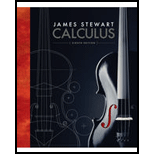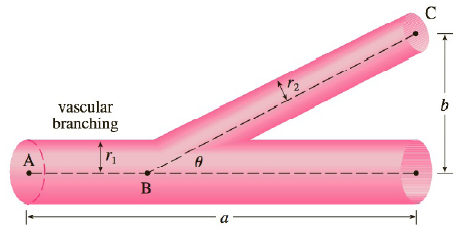
Concept explainers
The blood vascular system consists of blood vessels (arteries, arterioles, capillaries, and veins) that convey blood from the heart to the organs and back to the heart. This system should work so as to minimize the energy expended by the heart in pumping the blood. In particular, this energy is reduced when the resistance of the blood is lowered. One of Poiseuille’s Laws gives the resistance R of the blood as
where L is the length of the blood vessel, r is the radius, and C is a positive constant determined by the viscosity of the blood (Poiseuille established this law experimentally, butit also follows from Equation 8.4.2.) The figure shows a main blood vessel with radius

(a) Use poiseuille’s Law to show that the total resistance of the blood along the path ABC is
Where a and b are the distances shown in the figure.
(b) Prove that this resistance is minimized when
(c) Find the optimal branching angle (correct to the nearest degree) when the radius of the smaller blood vessel is two-thirds the radius of the larger vessel.
Want to see the full answer?
Check out a sample textbook solution
Chapter 3 Solutions
CALCULUS FULL TEXT W/ACCESS >CI<
- 2. Answer the following questions. (A) [50%] Given the vector field F(x, y, z) = (x²y, e", yz²), verify the differential identity Vx (VF) V(V •F) - V²F (B) [50%] Remark. You are confined to use the differential identities. Let u and v be scalar fields, and F be a vector field given by F = (Vu) x (Vv) (i) Show that F is solenoidal (or incompressible). (ii) Show that G = (uvv – vVu) is a vector potential for F.arrow_forwardA driver is traveling along a straight road when a buffalo runs into the street. This driver has a reaction time of 0.75 seconds. When the driver sees the buffalo he is traveling at 44 ft/s, his car can decelerate at 2 ft/s^2 when the brakes are applied. What is the stopping distance between when the driver first saw the buffalo, to when the car stops.arrow_forwardTopic 2 Evaluate S x dx, using u-substitution. Then find the integral using 1-x2 trigonometric substitution. Discuss the results! Topic 3 Explain what an elementary anti-derivative is. Then consider the following ex integrals: fed dx x 1 Sdx In x Joseph Liouville proved that the first integral does not have an elementary anti- derivative Use this fact to prove that the second integral does not have an elementary anti-derivative. (hint: use an appropriate u-substitution!)arrow_forward
- 1. Given the vector field F(x, y, z) = -xi, verify the relation 1 V.F(0,0,0) = lim 0+ volume inside Se ff F• Nds SE where SE is the surface enclosing a cube centred at the origin and having edges of length 2€. Then, determine if the origin is sink or source.arrow_forward4 3 2 -5 4-3 -2 -1 1 2 3 4 5 12 23 -4 The function graphed above is: Increasing on the interval(s) Decreasing on the interval(s)arrow_forwardQuestion 4 The plot below represents the function f(x) 8 7 3 pts O -4-3-2-1 6 5 4 3 2 + 1 2 3 5 -2+ Evaluate f(3) f(3) = Solve f(x) = 3 x= Question 5arrow_forward
- Question 14 6+ 5 4 3 2 -8-2 2 3 4 5 6 + 2 3 4 -5 -6 The graph above is a transformation of the function f(x) = |x| Write an equation for the function graphed above g(x) =arrow_forwardQuestion 8 Use the graph of f to evaluate the following: 6 f(x) 5 4 3 2 1 -1 1 2 3 4 5 -1 t The average rate of change of f from 4 to 5 = Question 9 10 ☑ 4parrow_forwardQuestion 15 ✓ 6 pts 1 Details The function shown below is f(x). We are interested in the transformed function g(x) = 3f(2x) - 1 a) Describe all the transformations g(x) has made to f(x) (shifts, stretches, etc). b) NEATLY sketch the transformed function g(x) and upload your graph as a PDF document below. You may use graph paper if you want. Be sure to label your vertical and horizontal scales so that I can tell how big your function is. 1- 0 2 3 4 -1- Choose File No file chosen Question 16 0 pts 1 Detailsarrow_forward
- helparrow_forwardQuestion 2 Let F be a solenoidal vector field, suppose V × F = (-8xy + 12z², −9x² + 4y² + 9z², 6y²), and let (P,Q,R) = V²F(.725, —.283, 1.73). Then the value of sin(2P) + sin(3Q) + sin(4R) is -2.024 1.391 0.186 -0.994 -2.053 -0.647 -0.588 -1.851 1 ptsarrow_forward1 pts Let F and G be vector fields such that ▼ × F(0, 0, 0) = (0.76, -9.78, 3.29), G(0, 0, 0) = (−3.99, 6.15, 2.94), and G is irrotational. Then sin(5V (F × G)) at (0, 0, 0) is Question 1 -0.246 0.072 -0.934 0.478 -0.914 -0.855 0.710 0.262 .arrow_forward
- Algebra & Trigonometry with Analytic GeometryAlgebraISBN:9781133382119Author:SwokowskiPublisher:Cengage
 College AlgebraAlgebraISBN:9781305115545Author:James Stewart, Lothar Redlin, Saleem WatsonPublisher:Cengage Learning
College AlgebraAlgebraISBN:9781305115545Author:James Stewart, Lothar Redlin, Saleem WatsonPublisher:Cengage Learning Algebra and Trigonometry (MindTap Course List)AlgebraISBN:9781305071742Author:James Stewart, Lothar Redlin, Saleem WatsonPublisher:Cengage Learning
Algebra and Trigonometry (MindTap Course List)AlgebraISBN:9781305071742Author:James Stewart, Lothar Redlin, Saleem WatsonPublisher:Cengage Learning  Algebra: Structure And Method, Book 1AlgebraISBN:9780395977224Author:Richard G. Brown, Mary P. Dolciani, Robert H. Sorgenfrey, William L. ColePublisher:McDougal Littell
Algebra: Structure And Method, Book 1AlgebraISBN:9780395977224Author:Richard G. Brown, Mary P. Dolciani, Robert H. Sorgenfrey, William L. ColePublisher:McDougal Littell Functions and Change: A Modeling Approach to Coll...AlgebraISBN:9781337111348Author:Bruce Crauder, Benny Evans, Alan NoellPublisher:Cengage Learning
Functions and Change: A Modeling Approach to Coll...AlgebraISBN:9781337111348Author:Bruce Crauder, Benny Evans, Alan NoellPublisher:Cengage Learning





